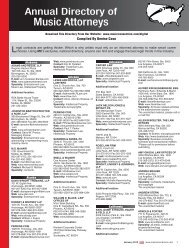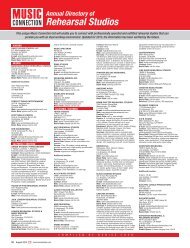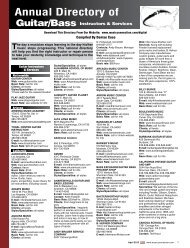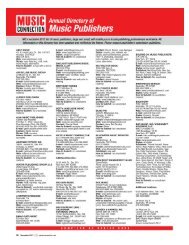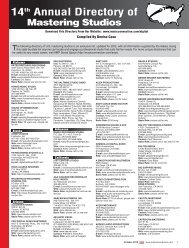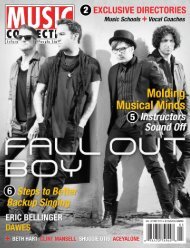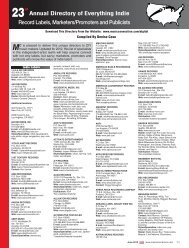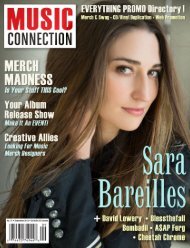www.musicconnection.com
January 2013 - Music Connection
January 2013 - Music Connection
- No tags were found...
Create successful ePaper yourself
Turn your PDF publications into a flip-book with our unique Google optimized e-Paper software.
NEW TOYS<br />
Sony DWZ Series Wireless<br />
The Sony DWZ Series of wireless microphone systems all use 24-bit<br />
linear PCM digital audio transmitted over the 2.4GHz band and <strong>com</strong>e in<br />
four different paired, transmitter and receiver packages: the DWZ-B30GB<br />
Guitar Set, DWZ-M50 Vocal Set, the DWZ-M70 Vocal/Speech Set, and<br />
the DWZ-B70HL Headset and Lavaliere Set. Especially notable for a wireless<br />
system at this price point is that both the DWZ-M70 and DWZ-B70HL<br />
packages have advanced digital signal processing to minimize audio feedback<br />
and 128-bit AES data encryption for secure audio transmission.<br />
Ideal and totally flexible for modest installed sound applications, houses<br />
of worship, corporate board rooms or night club stages, the DWZ systems<br />
have two methods for 2.4GHz frequency selection and the rack-mountable<br />
receivers (shown) have an integrated color LCD plus a built-in digital<br />
program EQ. The receivers connect easily using either balanced and<br />
unbalanced audio outputs and the handheld mics support both Sony’s or<br />
any third-party’s interchangeable mic capsule.<br />
The DWZ-M50 Vocal Set includes an interchangeable cardioid dynamic<br />
microphone capsule for its handheld transmitter and a half-rack size<br />
receiver while the DWZ-GB30 Guitar Set goes with a body pack transmitter<br />
with guitar cable tone control and <strong>com</strong>pact size receiver powered by<br />
an AC adapter, 9V battery or external DC.<br />
The DWZ-M70 Vocal/Speech Set includes an interchangeable cardioid<br />
dynamic microphone capsule for its handheld transmitter and half-rack<br />
size receiver and the DWZ-B70HL Headset and Lavaliere Set uses either<br />
a cardioid condenser headset microphone or uni-directional condenser<br />
lavaliere mic, body pack transmitter and receiver with advanced DSP<br />
functions. Check out http://sony.<strong>com</strong>/proaudio.<br />
PMC twotwo Series Powered<br />
Reference Monitors<br />
Professional Monitor Company (PMC) has<br />
two new handcrafted, 2-way powered<br />
reference studio monitors called the<br />
twotwo.5 and the scaled-up model,<br />
the twotwo.6 with the twotwo.8 version<br />
<strong>com</strong>ing soon.<br />
The set of pre-production<br />
twotwo.6s sent to me for evaluation<br />
have a 6.5-inch LF driver, measure<br />
(H 406 X W 194 X D 364mm), and a<br />
useable frequency range of 40Hz to 25kHz.<br />
PMC’s Advanced Transmission Line, an<br />
internal labyrinth within the cabinet, is used to load<br />
the bass driver and extend the low frequency response<br />
of this <strong>com</strong>pact monitor.<br />
Both the twotwo.5’s and .6’s use the same 27-mm soft-dome<br />
HF driver, the same pair of Class-D power amps—150-watt LF and<br />
50-watt HF, and both accept either balanced or unbalanced analog audio<br />
input by way of the rear panel XLR and RCA jacks.<br />
These monitors also accept digital audio input via a rear panel AES3<br />
XLR connector and use their own onboard DSP for automatic sample rate<br />
conversion of all in<strong>com</strong>ing digital audio to 24-bit/96kHz, internal A/D-D/A,<br />
user-equalization, crossover options and driver protection. With digital<br />
audio operation, two RJ45 connectors on the rear panel convey volume<br />
data and digital audio over standard CAT-5 cables to any number of PMC<br />
monitors daisy chained together.<br />
I’m very impressed but still experimenting with their setup in my small<br />
room. The built-in DSP works well to shape the monitors’ frequency balance<br />
to sound their best considering my small room’s inherent room mode<br />
issues along with my own monitoring preferences. They are an honest<br />
pair of monitors that make me work harder at perfecting the sound of my<br />
mixes. I like their look and styling; their deep cabinets and narrow width<br />
give them a diminutive look but sonically, they are far from unnoticed; they<br />
sound huge. The PMC twotwo.6s are big winners here at my Tones 4 $<br />
Studios.<br />
Visit http://pmc-speakers.<strong>com</strong> for more technical details and information on<br />
both the twotwo.5 and twotwo.6 monitors as well as the entire Professional<br />
Monitor Company line of active and passive monitoring systems.<br />
—BARRY RUDOLPH barry@barryrudolph.<strong>com</strong><br />
CAD Audio Sessions MH510 Headphones<br />
CAD Audio offers a pair of headphones with specs that rival or exceed<br />
that of the most expensive professional studio headphones you’d find in a<br />
world-class recording studio. The result of a decade-long collaboration of<br />
experience and professional audio expertise, the Sessions MH510 headphones<br />
<strong>com</strong>e with features and accessories found with studio phones starting<br />
at $300.<br />
You get an extra pair of velveteen ear cushions in addition to the included<br />
leatherette set. I like that you get both straight and curly cords and both<br />
have locking connectors to change/replace cords. Each pair <strong>com</strong>es with a<br />
leatherette carry pouch, a screw-on 1/4-inch stereo gold-plated adapter and,<br />
just for fun, there is a choice of black, white/red, black/chrome and black/<br />
orange colors.<br />
I received a pair of all black MH510 headphones and immediately<br />
plugged them into my Aphex Systems Model 454 HeadPod studio headphone<br />
box. The MH510s have 26-ohm impedance, 50-mm neodymium<br />
drivers and a maximum power rating of 3-watts. You’ll distort the Aphex amp<br />
before overdriving them.<br />
Being able to handle up to<br />
3-watts of power is the best headphone<br />
feature in the recording<br />
studio world. The voice coils in<br />
the drivers of studio phones will<br />
burn out with hours of excessive<br />
and constant volume levels —<br />
even when the headphones lay<br />
on the floor unused. Combine that with the “perfect storm” of physical abuse<br />
and accidental spikes caused by a bad/intermittent connection somewhere<br />
in the signal chain and you’ve got another set of dead soldiers.<br />
In my listening tests, I found that the MH510 headphones are built for<br />
loud playback with a thick overall sound with plenty of bass down to the<br />
subsonic. They are more efficient than my other studio phones—meaning<br />
more volume for the same power from the headphone amp. They are also<br />
slightly lighter weight, very <strong>com</strong>fortable and seal well over my ears for minimal<br />
headphone spill.<br />
The super-rugged and stylish CAD Audio Sessions MH510 headphones<br />
sell for $159 MSRP. For more about them, go to http://cadaudio.<strong>com</strong>/<br />
MH510.php.<br />
Steinberg Cubase 7 and Cubase Artist 7<br />
The significant new features for both Cubase 7 and Cubase Artist 7<br />
are the <strong>com</strong>pletely redesigned MixConsole mixers. The Channel Settings<br />
window specifies channel/track order for the all-new channel strip.<br />
MixConsole is laid out and looks like a beautiful, easy on the eyes analog<br />
audio console mixer.<br />
The channel strips have high and low-pass filters, a noise gate, fourband<br />
StudioEQ, three different <strong>com</strong>pressors, a spectrum analyzer, tube/<br />
tape saturation section, a brick wall limiter and a maximizer.<br />
You get Voxengo’s studio-grade 64-band spline CurveEQ, a large,<br />
built-in mix bus meter with a choice of various standards including<br />
Europe’s EBU R128 loudness for broadcasters as well as Bob Katz’s<br />
K-System metering. There is also VST Connect SE for Internet recording<br />
sessions and the latest version of MixConvert for high quality down mixing<br />
of multi-channel surround sound mixes.<br />
On the music <strong>com</strong>posing side is Chord Track, a dedicated track within<br />
the Project window that identifies the music’s harmony structure and<br />
generates metadata about chord quality and scale. Changes in Chord<br />
Track can change the harmonic content of both MIDI sequences as well<br />
as audio tracks that have already been analyzed with VariAudio.<br />
Chord Assistant <strong>com</strong>es with Cubase 7 and provides the ultimate tool<br />
for songwriters looking for just the right chord and/or suggesting harmonically<br />
related chord progressions.<br />
There are many new samples, instruments,<br />
and MIDI loops for HALion Sonic SE, Goove<br />
Agent and Beat Designer products. Steinberg also<br />
announced Nuendo 6, sharing many of the same<br />
great improvements now available in Cubase 7.<br />
Cubase 7 sells for $599.99 and Cubase Artist<br />
7, at $329.99, is cross-platform and runs 32/64-<br />
bit for Windows and Mac OS X Intel. For now,<br />
check out http://steinberg.net/en/products/cubase/<br />
whats_new.html.<br />
Barry Rudolph is a recording engineer/mixer with over 30 gold and platinum RIAA<br />
awards to his credit. He has recorded and/or mixed: Lynyrd Skynyrd, Hall & Oates,<br />
Pat Benatar, Rod Stewart, the Corrs and Robbie Nevil.<br />
Barry has his own futuristic music mixing facility and also teaches recording<br />
engineering at Musician’s Institute, Hollywood, CA. http://<strong>www</strong>.barryrudolph.<strong>com</strong><br />
12 January 2013 <strong>www</strong>.<strong>musicconnection</strong>.<strong>com</strong>



